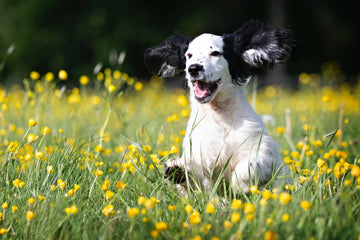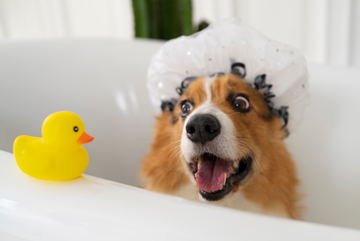If you’ve ever watched your dog chow down their food in what seems like a split second, you’re not alone. Some dogs have a talent for inhaling their meals faster than you can say "sit," and it’s not always a good thing. While it might seem harmless at first, eating too fast can lead to some serious health issues. If you’ve noticed your dog eating at lightning speed, it’s important to understand the reasons behind this behavior and how you can help slow them down.
In this post, we’ll explore why dogs eat too fast, the potential risks associated with it, and the practical steps you can take to encourage healthier eating habits for your furry friend. So, whether your dog is scarfing down their kibble like it’s the last meal on earth or you're just trying to get them to take a little more time with their bowl, this guide is here to help.
1. Why Do Dogs Eat So Fast?
Before we dive into solutions, let’s explore the reasons why some dogs wolf down their food in record time. Understanding why your dog might be eating too fast can give you insight into their behavior and help you find the best approach to address the issue.
Instincts at Play
Dogs, even though domesticated, are still deeply connected to their wild instincts. In the wild, canines had to compete for food and eat quickly to avoid losing their meal to another predator or pack member. This instinct still lives on in some dogs today, especially those with a high prey drive or those that came from competitive feeding environments (like a shelter or a home with other pets).
Anxiety and Stress
Just like humans, dogs can be affected by stress and anxiety, and for some, eating quickly can be a way to cope with these feelings. A dog that’s anxious about being alone, or one who feels insecure around other pets, may scarf down food in an attempt to avoid the feeling of scarcity. In a home environment, this could be exacerbated if there’s a history of competition for food.
Poor Eating Habits from the Past
If your dog had a rough start in life, such as time spent in a shelter or a foster situation with limited food, they may have developed a habit of eating quickly to ensure they get their share. For these dogs, eating fast becomes a survival mechanism they learned early on.
Hunger or Unbalanced Meals
A dog that is genuinely hungry, or whose meals are unbalanced, might be compelled to eat quickly. It’s important to ensure your dog’s meals are nutritionally complete, as an insufficient diet can lead to a dog scarfing down their food in an effort to get more.
2. The Risks of Eating Too Fast
While a fast eater might be amusing to watch, there are several health risks associated with this behavior that you should be aware of. Eating too quickly can lead to a number of problems that could affect your dog’s long-term well-being.
Bloat (Gastric Dilatation-Volvulus)
One of the most serious conditions caused by eating too fast is bloat, or gastric dilatation-volvulus (GDV). Bloat occurs when the stomach expands with gas, and in some cases, it can twist, cutting off the blood supply to the stomach and other organs. This condition is a medical emergency and can be fatal if not treated promptly. While it’s more common in large, deep-chested breeds (like Great Danes or German Shepherds), any dog that eats too fast is at risk.
Choking
Dogs that gulp down their food without chewing run the risk of choking, which can be dangerous, especially if the food gets lodged in the throat. Choking can occur more easily with dry food or large pieces of kibble, so it’s important to monitor your dog’s eating habits.
Digestive Issues
Eating too quickly can also lead to digestive discomfort, such as indigestion, vomiting, or diarrhea. When dogs swallow food without chewing it properly, their stomachs have to work harder to break down the food, which can lead to upset stomachs and other gastrointestinal issues.
Weight Gain
Fast eaters tend to be more prone to overeating, which can contribute to weight gain and obesity. When dogs eat too quickly, they don’t give their bodies enough time to signal that they’re full, which means they may continue eating beyond their needs. This is especially concerning if your dog is already prone to gaining weight.
3. How to Help Your Fast Eater
If your dog is eating too fast, there’s good news: There are several strategies you can try to slow them down, promote healthier eating habits, and reduce the risks associated with eating too quickly. Here are some effective solutions to help your dog eat at a more reasonable pace.
Slow Feeder Bowls
One of the most popular solutions to help slow down a fast eater is using a slow feeder bowl. These bowls are designed with ridges or obstacles that make it harder for your dog to gulp down their food in one go. Instead, your dog has to work around the obstacles, which encourages them to eat more slowly. A Slow Feeding Puzzle Toy is another great option for this, as it adds an extra challenge for your dog by requiring them to figure out how to get the food out.
These slow feeders not only help regulate your dog’s eating speed but also stimulate their brain and encourage healthy eating habits.
Puzzle Feeders
For dogs who tend to inhale their food, a puzzle feeder can be a game-changer. These toys force your dog to figure out how to get their food, which significantly slows them down and makes mealtime more enjoyable. Some puzzle feeders even allow you to hide treats inside, making it a fun and rewarding experience for your dog while also keeping them mentally stimulated.
Food Dispensing Toys
Another great way to slow down your dog’s eating is to use food dispensing toys. These toys are designed to release small portions of food at a time, forcing your dog to work for their meal. For example, a Rolling Slow Feeder Dog Toy could be a perfect solution. It not only slows down eating but also keeps your dog entertained and mentally engaged while they eat.
Split Meals into Smaller Portions
If your dog tends to overeat at one sitting, try breaking their meals into smaller portions throughout the day. Instead of giving them one large meal, offer two or three smaller meals, spaced out throughout the day. This reduces the temptation to gorge and gives their digestive system a chance to keep up.
Create a Calm Eating Environment
For dogs that eat quickly due to anxiety or stress, it’s important to create a calm, quiet environment during mealtime. Feed your dog in a place where they feel safe and secure, away from distractions or potential competitors (like other pets). You can also use food puzzles or treat-dispensing toys to keep their focus on eating rather than becoming anxious about their surroundings.
4. Additional Tips for a Healthier Mealtime
Aside from using slow feeders and puzzle toys, here are a few additional tips to help regulate your dog’s eating habits and promote overall health:
Encourage Chewing: Encourage your dog to chew their food by offering larger kibble or pieces of food that are harder to swallow. Chewing helps them digest their food better and slows down the eating process.
Monitor Their Weight: Keep track of your dog’s weight to ensure they’re not overeating. Overweight dogs are more likely to develop health issues, so monitoring their food intake is essential.
Visit the Vet: If your dog’s fast eating is a new behavior or is causing health issues, it’s always a good idea to check in with your vet. They can help identify any underlying issues, such as digestive problems or anxiety, that might be contributing to the behavior.
Slowing Down Can Lead to Healthier, Happier Meals
Eating too quickly might seem like a harmless habit, but it can actually lead to serious health problems for your dog. Whether it’s bloat, choking, digestive issues, or weight gain, the risks of eating too fast are not something to take lightly. Fortunately, with a few simple changes — like using slow feeder bowls, puzzle toys, and creating a calm eating environment — you can help your dog eat at a healthier pace, reduce their risk of health problems, and make mealtime more enjoyable for both of you.
Remember, a little patience and creativity can go a long way in turning your dog into a more mindful eater. So, next time your pup is gobbling down their meal too fast, try one of these strategies and watch them slow down, chew a little more, and enjoy their food in a healthier, more relaxed way. Your dog will thank you for it — and you’ll likely see the benefits in their overall health and well-being.







